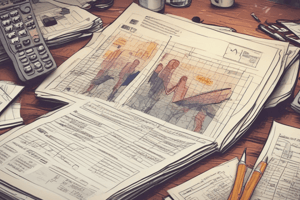Podcast
Questions and Answers
What are the three financial statements?
What are the three financial statements?
- Income statement
- Balance sheet
- CF statement
- All of the above (correct)
How does the board of directors use financial statements?
How does the board of directors use financial statements?
To hold management accountable and make board-level decisions about corporate strategy.
How does company management use financial statements?
How does company management use financial statements?
To measure performance and make strategic, operating, and financial decisions.
How do creditors use financial statements?
How do creditors use financial statements?
How do investors use financial statements?
How do investors use financial statements?
How do acquirers use financial statements?
How do acquirers use financial statements?
How do regulators use financial statements?
How do regulators use financial statements?
What is the purpose of the income statement?
What is the purpose of the income statement?
Revenue(sales) is ________.
Revenue(sales) is ________.
COGS is ________.
COGS is ________.
Gross profit is ___.
Gross profit is ___.
What are operating expenses?
What are operating expenses?
Operating income, aka ___, is _____.
Operating income, aka ___, is _____.
What are non-operating expenses?
What are non-operating expenses?
Net income/net earnings are ________.
Net income/net earnings are ________.
What does the balance sheet show?
What does the balance sheet show?
Accounts receivable is ________.
Accounts receivable is ________.
What are fixed assets?
What are fixed assets?
Match debt with its definition and equity with its definition:
Match debt with its definition and equity with its definition:
Working capital is not on the balance sheet, but it can be derived from balance sheet accounts. Working capital is a measure of a firm's ________.
Working capital is not on the balance sheet, but it can be derived from balance sheet accounts. Working capital is a measure of a firm's ________.
Non-cash current assets ________.
Non-cash current assets ________.
Non-debt current liabilities _______.
Non-debt current liabilities _______.
What might happen if a company's non-cash current assets do not exceed non-debt current liabilities?
What might happen if a company's non-cash current assets do not exceed non-debt current liabilities?
Flashcards are hidden until you start studying
Study Notes
Financial Statements Overview
- Three key financial statements: income statement, balance sheet, cash flow statement.
- These statements communicate an organization’s financial conditions, operational results, and activities to stakeholders.
Board of Directors' Use of Financial Statements
- They hold management accountable for performance.
- Inform board-level decisions related to corporate strategy.
Management's Use of Financial Statements
- Used to measure organizational performance.
- Aid in making strategic, operational, and financial decisions.
Creditors' Use of Financial Statements
- Evaluate creditworthiness, liquidity, and potential bankruptcy risk.
Investors' Use of Financial Statements
- Facilitate decisions on buying or selling equity investments.
Acquirers' Use of Financial Statements
- Assess valuation and inform investment decisions.
Regulators' Use of Financial Statements
- Ensure companies comply with regulations and legal requirements.
Income Statement Purpose
- Presents operating results over a specific period.
- Indicates profitability, showing whether the company made or lost money.
Revenue Definition
- The amount charged for goods or services delivered.
Cost of Goods Sold (COGS)
- Represents direct costs associated with producing revenue, including raw materials and labor expenses.
Gross Profit Definition
- Calculated as revenue minus COGS.
- Indicates efficiency in labor and supply usage in production.
Operating Expenses Definition
- Encompasses all other expenses necessary for business operations, such as marketing and management salaries.
Operating Income (EBIT)
- Represents revenue minus COGS and operating expenses.
- Reflects a company's earning power from ongoing operational activities.
Non-Operating Expenses Definition
- Include costs not related to the core business activities, such as interest expenses.
Net Income (Net Earnings)
- Calculated by subtracting total expenses from revenue.
- Reflects the increase in shareholder value resulting from the company's operations.
Balance Sheet Purpose
- Shows an organization's financial position at a specific point in time.
- Displays controlled resources (assets) and associated claims (liabilities and equity).
Accounts Receivable Definition
- The amount owed to an organization for products or services sold.
Fixed Assets Definition
- Long-term assets and property not easily converted to cash, valued for over one year, including plants and equipment.
Debt vs. Equity
- Debt accounts for obligations owed to creditors.
- Equity represents cumulative shareholder investment plus net income over time.
Working Capital Definition
- A measure of a firm's efficiency and short-term financial health.
- Calculated as non-cash current assets minus non-debt current liabilities.
Non-Cash Current Assets
- Include all assets (excluding cash) expected to convert to cash within one year like accounts receivable and inventory.
Non-Debt Current Liabilities
- Obligations due within one year, excluding short-term debts, such as accounts payable and accrued liabilities.
Working Capital Challenges
- A negative balance indicates potential difficulties in repaying creditors and suppliers in the short term.
- Positive or negative working capital influences whether it can be a source of cash.
Differences Between Debt and Equity
- Debt often incurs lower costs and has different claims and rates of return compared to equity.
Studying That Suits You
Use AI to generate personalized quizzes and flashcards to suit your learning preferences.




